- 11/12/2021
- 14 Min Read
- By: Christian Schaefer
The Definitive Guide To BMW X5 & X6 Suspension & Brakes (BMW F15 X5 & F16 X6)
The BMW X5 was never supposed to be an SUV. Instead, BMW called it an SAV or Sports Activity Vehicle. The idea was to create a large family car with the body of an SUV but with the driving characteristics of their sports sedans. That driving dynamic was readily apparent in the original X5 and has shown itself to be a recurring trait in every X5 since. Their on-road poise regularly gets them high marks from independent journalists compared to similar products from Mercedes, Porsche, Audi, and Lexus. The fourth-generation X5 ended its run in 2018, and it now exists as an interesting, capable, and modern choice for a used SUV. If suspension feel is your number one priority, the X5 is going to be difficult to beat.
Over the five-year run of the two chassis, five different shock and spring options were available. Standard on the less expensive models was coil spring suspension without any active, adaptive, or adjustable features. Optionally on the less costly and standard on the upper models was one of four adaptive shock and spring options. Regardless of the damping setup, all of the suspension packages use the same architecture. Upfront is a double-wishbone design, utilizing an upper wishbone and two lower arms that form the lower wishbone. The rear uses an integral link suspension. A large lower control arm supports the knuckle and rear spring, while two upper arms control the toe and camber angles. Beyond that, the components begin to diverge between option packages. Let's get into what separates those options.
BMW X5 & X6 Suspension Packages (F15 & F16)
The third-generation BMW X5 and second-generation X6 were both given four different optional suspension packages. Each one has an adaptive component to it, allowing the driver to adjust its settings using the Driver Experience Control switch. The packages and their terminology can get quite overwhelming, but they are fairly straightforward when reduced to their essential elements.
Dynamic Active Suspension
BMW’s Dynamic Active Suspension doesn’t affect the spring and shock package like the three other options. Instead, the additions made to the suspension are electronically and hydraulically controlled adaptive sway bars and rear torque vectoring. Dynamic Drive active roll stabilization is the official name given to the sway bars. These adaptive bars use a motor mounted in the center of the bar. The left and right sides ride on bearings inside the motor and act independently.
When extra roll resistance is needed to keep the chassis composed in the bends, an electro-hydraulic valve block activates and uses power steering fluid to work the motor. Controlling the hydraulic pressure is a small computer that combines the information sent to it by the steering angle sensor, the stability control sensors, and a lateral acceleration sensor to determine how stiff the sway bars need to be. Additionally, the Dynamic Active Suspension option includes DPC, or Dynamic Performance Control, BMW’s torque vectoring system. That system uses an electronically controlled rear differential that is able to distribute power to the wheel needing it the most.
Comfort Adaptive Suspension
The Comfort Adaptive Suspension package is a shock and spring change over the standard coil suspension. The largest change comes in the form of a pair of rear air springs in place of the standard coil springs. Depending on payload, various sensors work with the air suspension control unit to automatically raise or lower the rear of the vehicle.
Not to be outdone by the springs, the comfort package also includes electronically-controlled adaptive dampers or Dynamic Damper Control. A control unit on each wheel reads movements four hundred times a second and adjusts the shock absorbers accordingly. The setting chosen by the driver determines the way they react. The driver can choose between two settings using the Driver Experience Control switch, one being a softer setting while the other a firmer setup.
Professional Adaptive Suspension
The professional adaptive suspension system is a combination of the Comfort and Dynamic suspension packages. The automatically-leveling air suspension and Dynamic Dampers are paired with the Dynamic Drive sway bars and the DPC to offer a complete suspension upgrade over the standard suspension. This system is nearly identical to Porsche’s PASM and PDCC that it introduced on the first-generation Cayenne.
Adaptive M Suspension
As the name implies, this is the top-level suspension option in terms of performance. As part of the M-Sport pack, the Adaptive M Suspension offers a firmer suspension than standard, sacrificing some comfort for better handling capabilities. Think of it as a Professional Adaptive package on steroids. The front coil springs and the rear air springs utilize a stiffer compression rate for better control. The Dynamic Drive sway bars are used, too, providing extra roll resistance. In the iDrive system, there are three damping settings to choose from: Comfort, Sport, and Sport+.
BMW X5 & X6 Suspension Design (F15 & F16)
Every F15/F16 X5/X6 from BMW is going to have at least one pair of coil springs. Regardless of whichever suspension package is chosen, the front springs are always coils. However, the basic suspension, mostly found on the xDrive35i models, is coil springs front and rear.
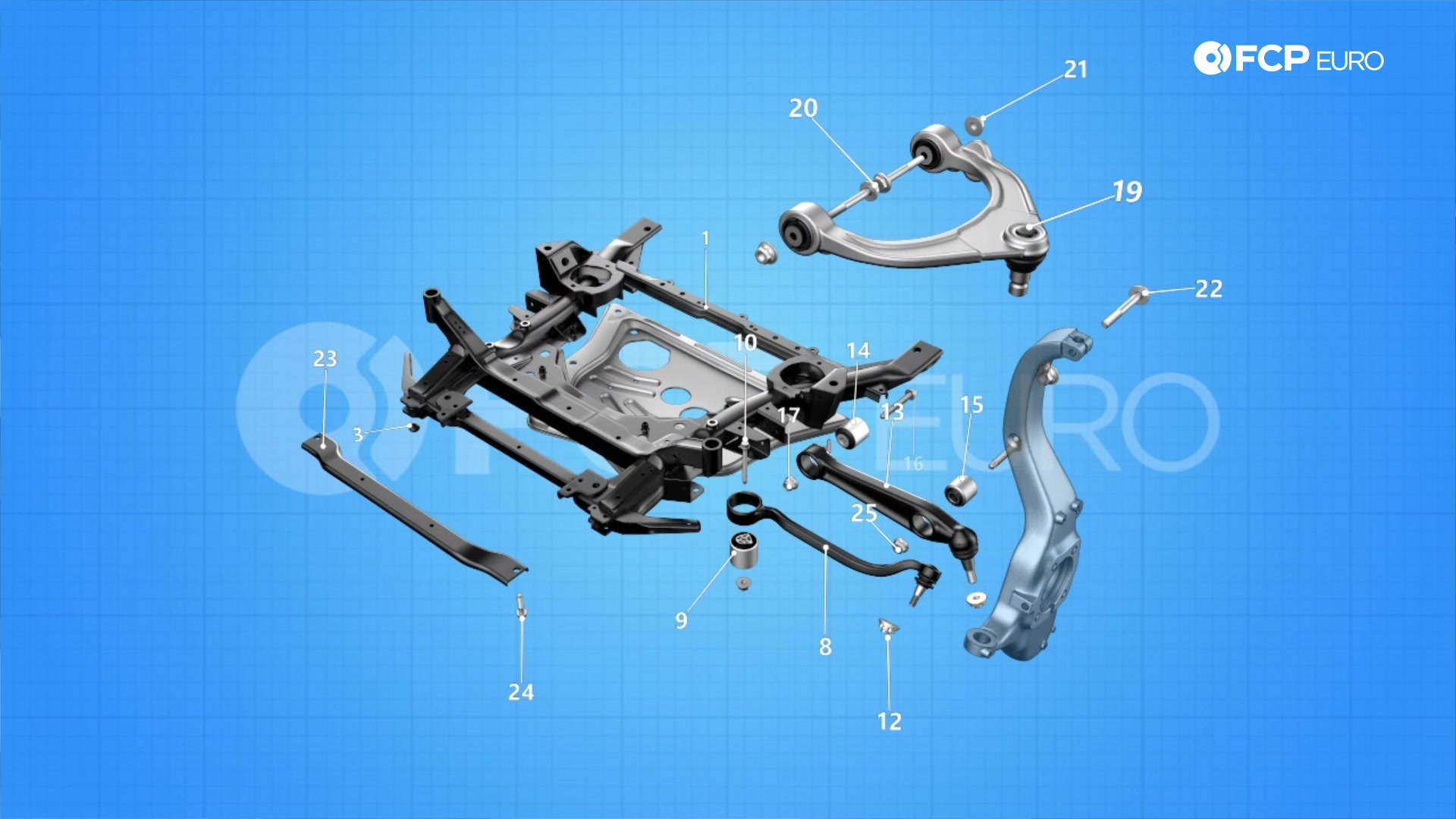
The front suspension architecture between the basic and optional suspensions is the same. The addition of adaptive dampers doesn’t change anything, though the M suspension has slightly stiffer coils. Any control arm or bushing-related problem will be the same between suspension packages.
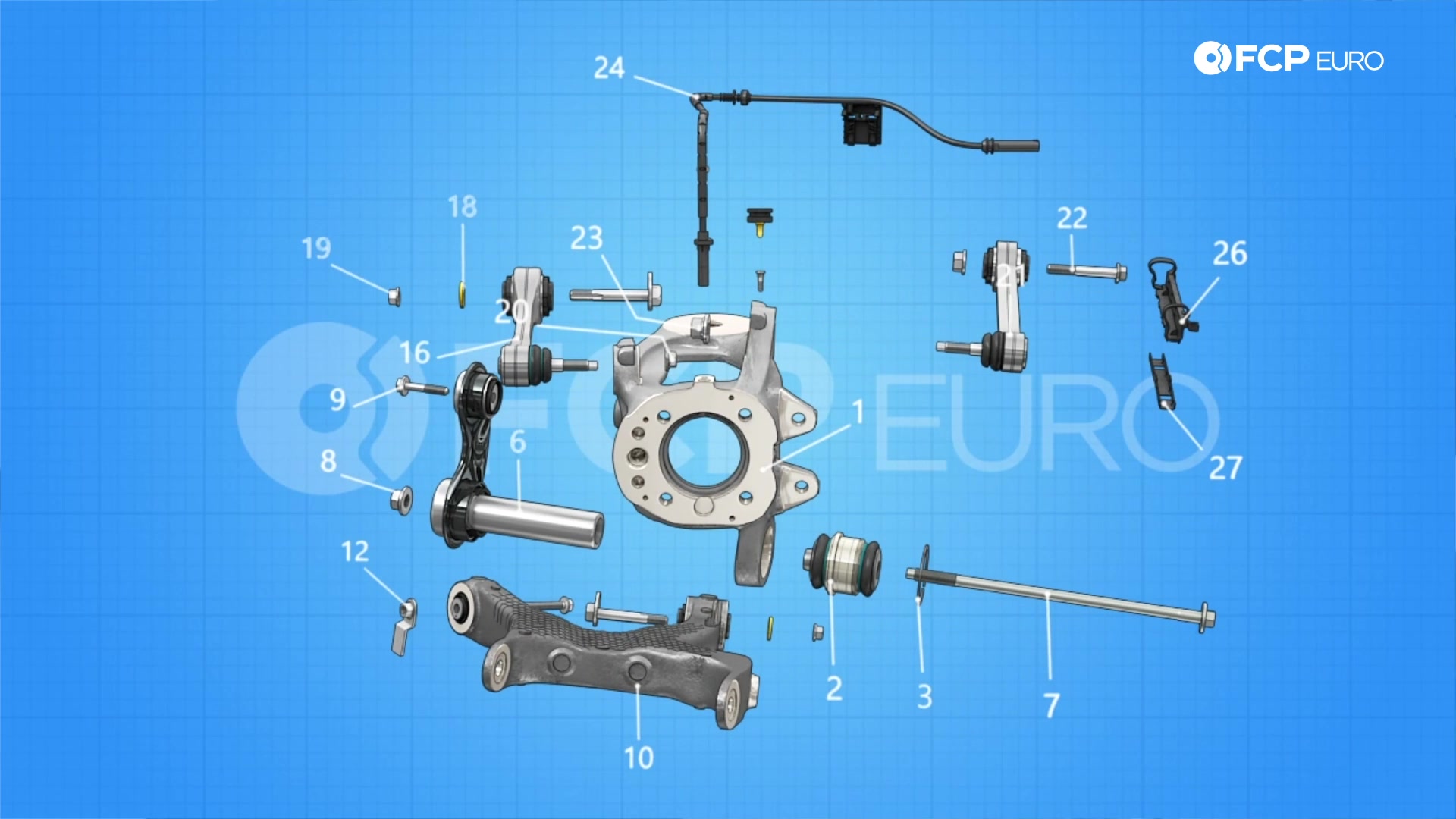
The rear suspension, however, differs between the optional and standard. The comfort, professional, and M suspension packages utilize rear air springs instead of traditional steel coil springs. To keep things “simple,” the air springs bolt in where the standard coil springs normally would, allowing BMW to have one standard control arm for the rear suspension.
BMW X5 & X6 Suspension Problems (F15 & F16)
Front Lower Control Arms
The lower “wishbone” of the front suspension consists of two arms, the lower control arm, and the thrust arm. The thrust arm is responsible for keeping the knuckle centered in position. The lower control arm acts as the strut’s lower mounting point as well as the controller of the knuckle’s vertical movement.
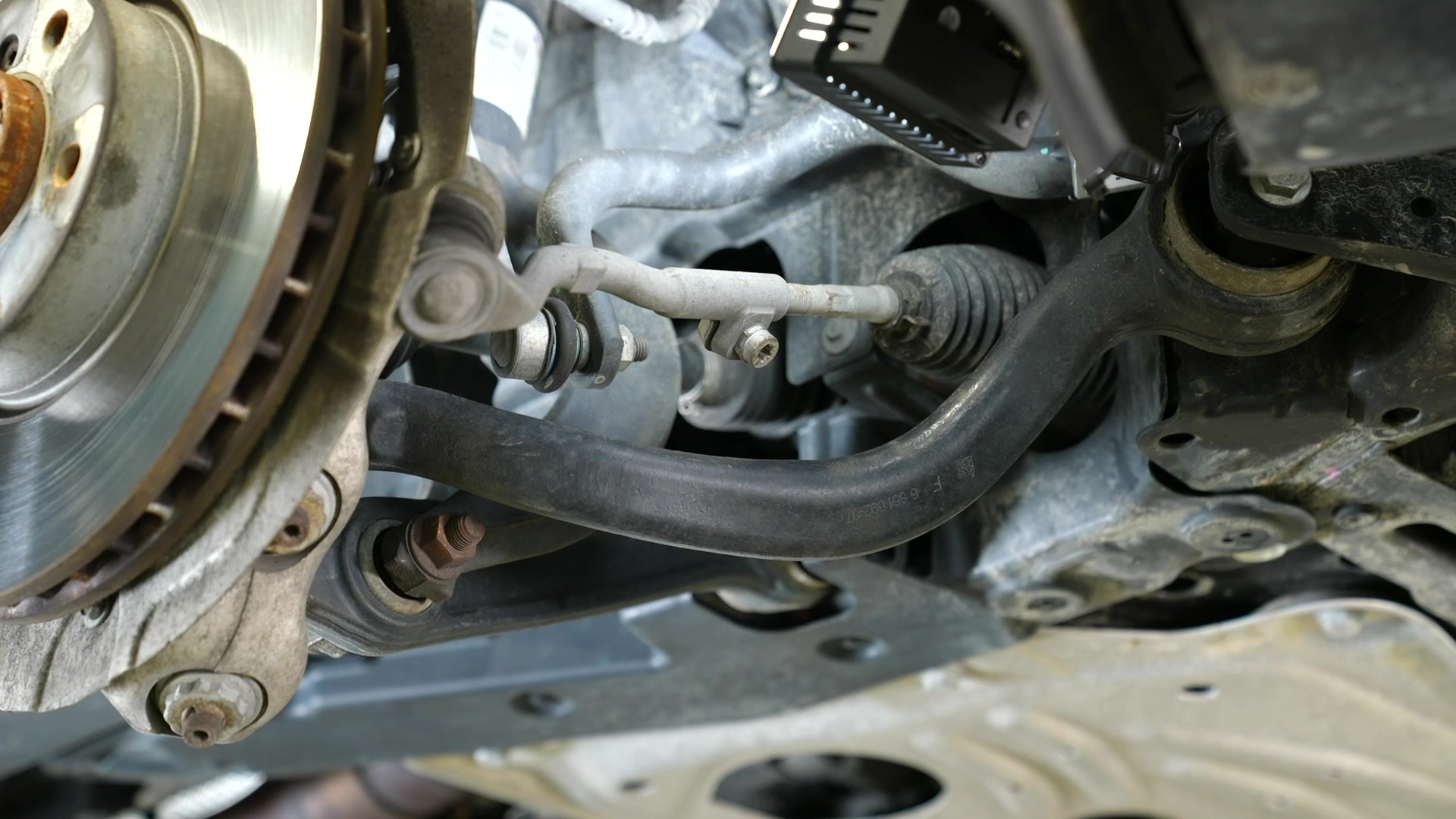
The thrust arm’s inner bushing will be the most common failure in the F15/F16 front suspension. A majority of the vehicle's forward force is applied to that inner bushing, causing it to wear quicker than the others. BMW uses a liquid-filled inner bushing for the thrust arm. It will leak fluid once it fails, so look around the bushing for a greasy/oil residue when checking its condition. You’ll feel it begin to fail as it will cause a vibration l similar to an unbalanced wheel. Additionally, check the ball joint that links the thrust arm to the knuckle. In good condition, the ball joint will be tough to move by hand. Replace the arm if the ball joint moves freely easily.
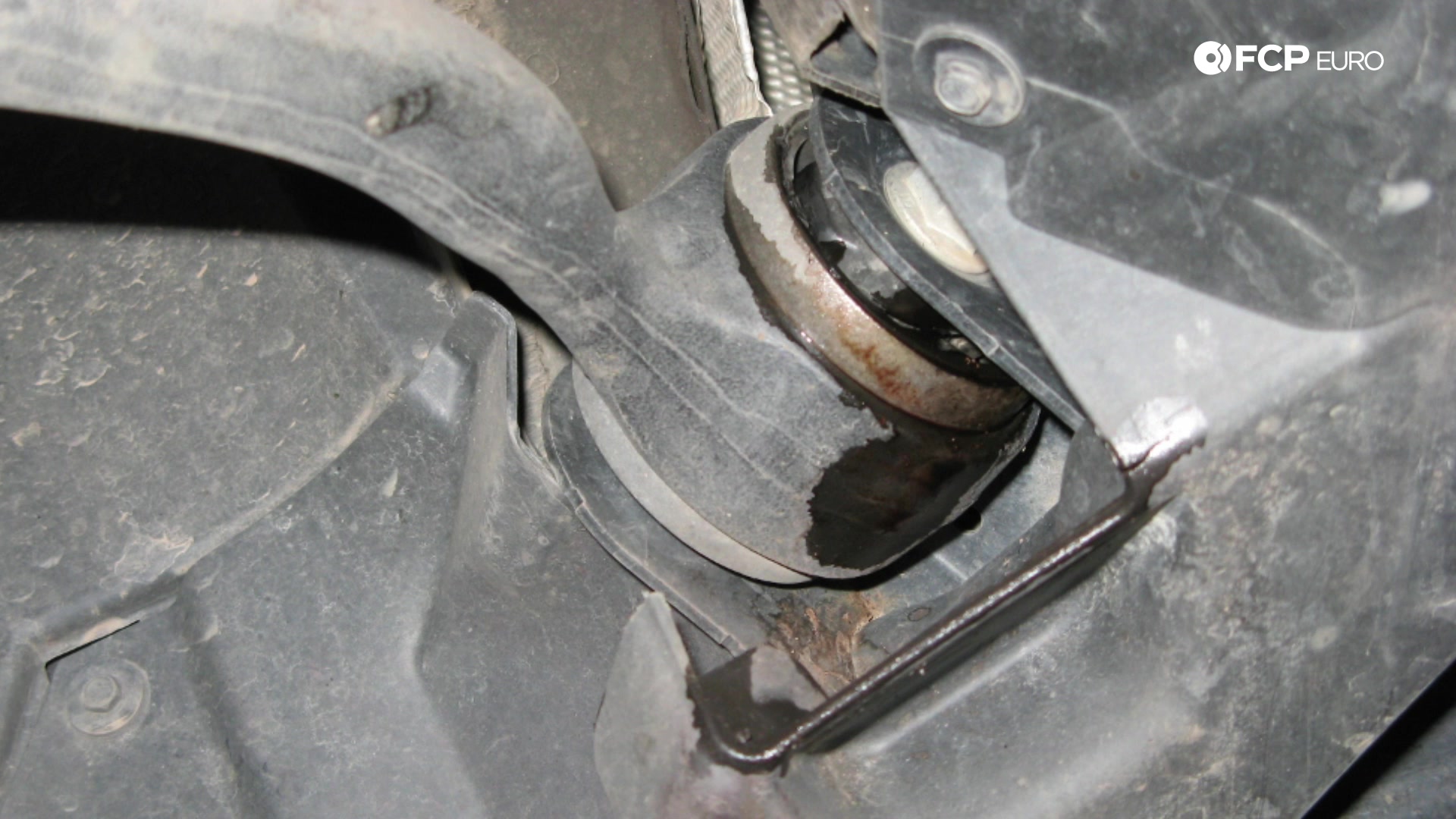
The lower control arm can also be a source of front suspension noise. The most common wear item there is the lower strut mount bushing. That bushing carries the weight and forces of the front strut, leading to a fairly rapid degradation once it begins to fail. Typically, you’ll get a knocking or clunking as you drive over bumps or surface changes. The individual bushing is not replaceable, so a new control arm is the only solution. Also, just like the thrust arm, the control arm uses a ball joint to mount to the knuckle. Check that ball joint for wear also. Vague or sloppy steering are both symptoms of worn ball joints.
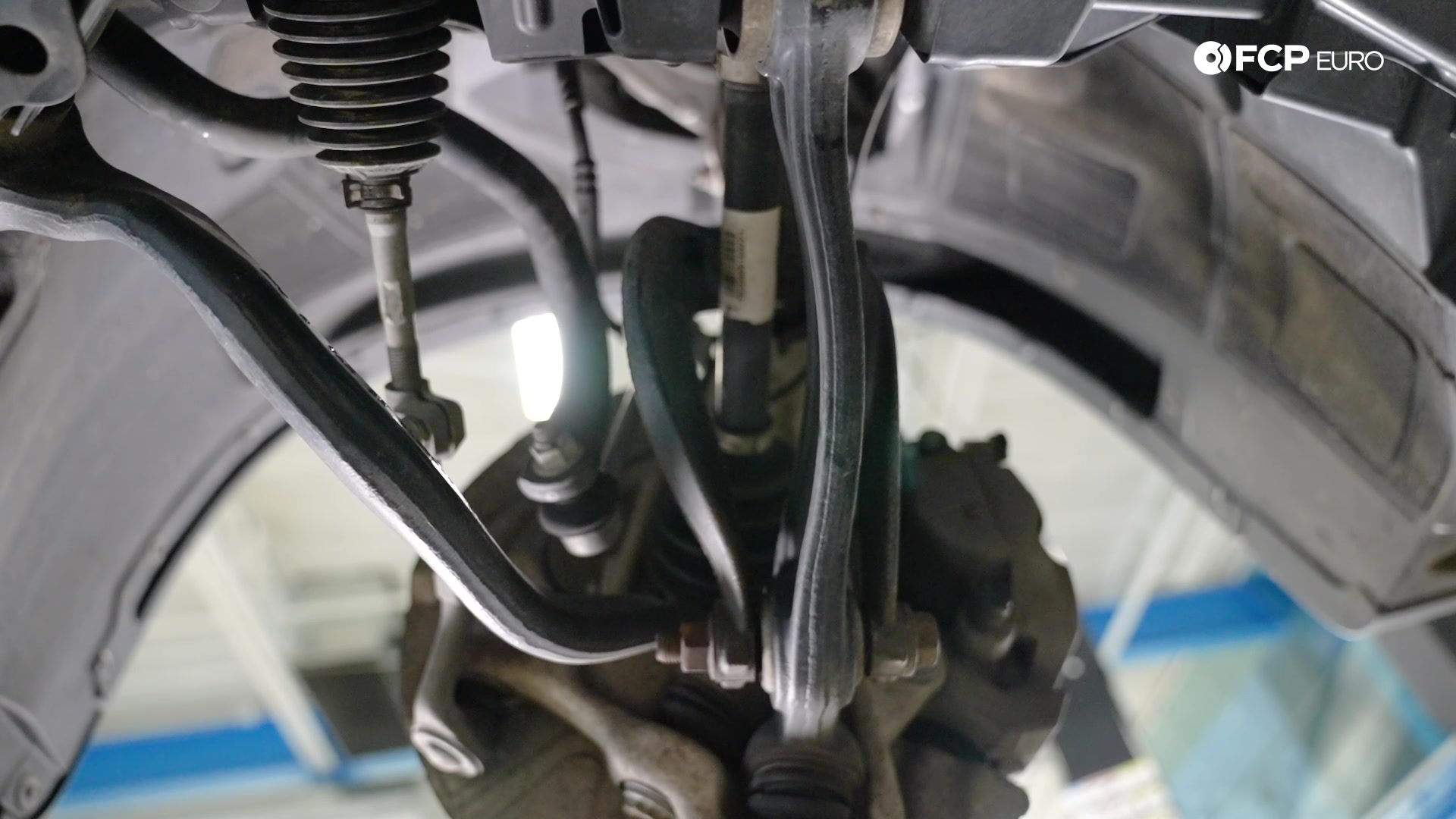
Checking the suspension can be done rather easily. Raise up the vehicle and grab the wheel in question at the 9 and 3 o’clock positions. Wiggle/shake it back and forth, then move your hands to 12 and 6, and repeat. If excess movement is present, remove the wheel and examine ball joints and tie rod ends.
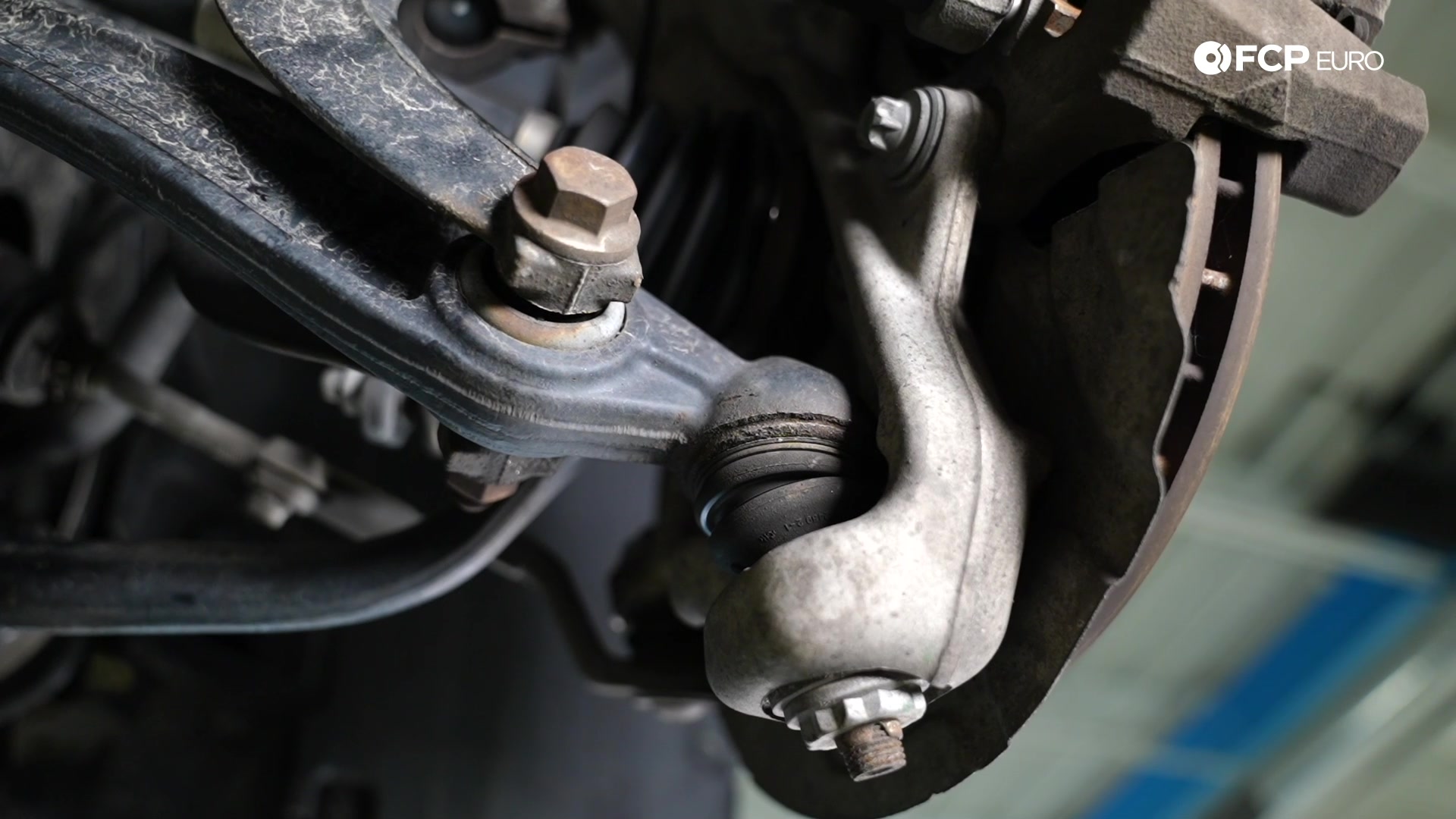
Front Upper Wishbone
The upper portion of BMW’s “double wishbone” front suspension is actually a wishbone. The U-shaped suspension arm mounts directly to the inner chassis rail and uses a ball joint to connect to the upper portion of the knuckle. These upper arms are not adjustable and feature no form of camber correction. Their ball joints and inner bushings also aren’t replaceable, so a new wishbone is required if one of those components fails.
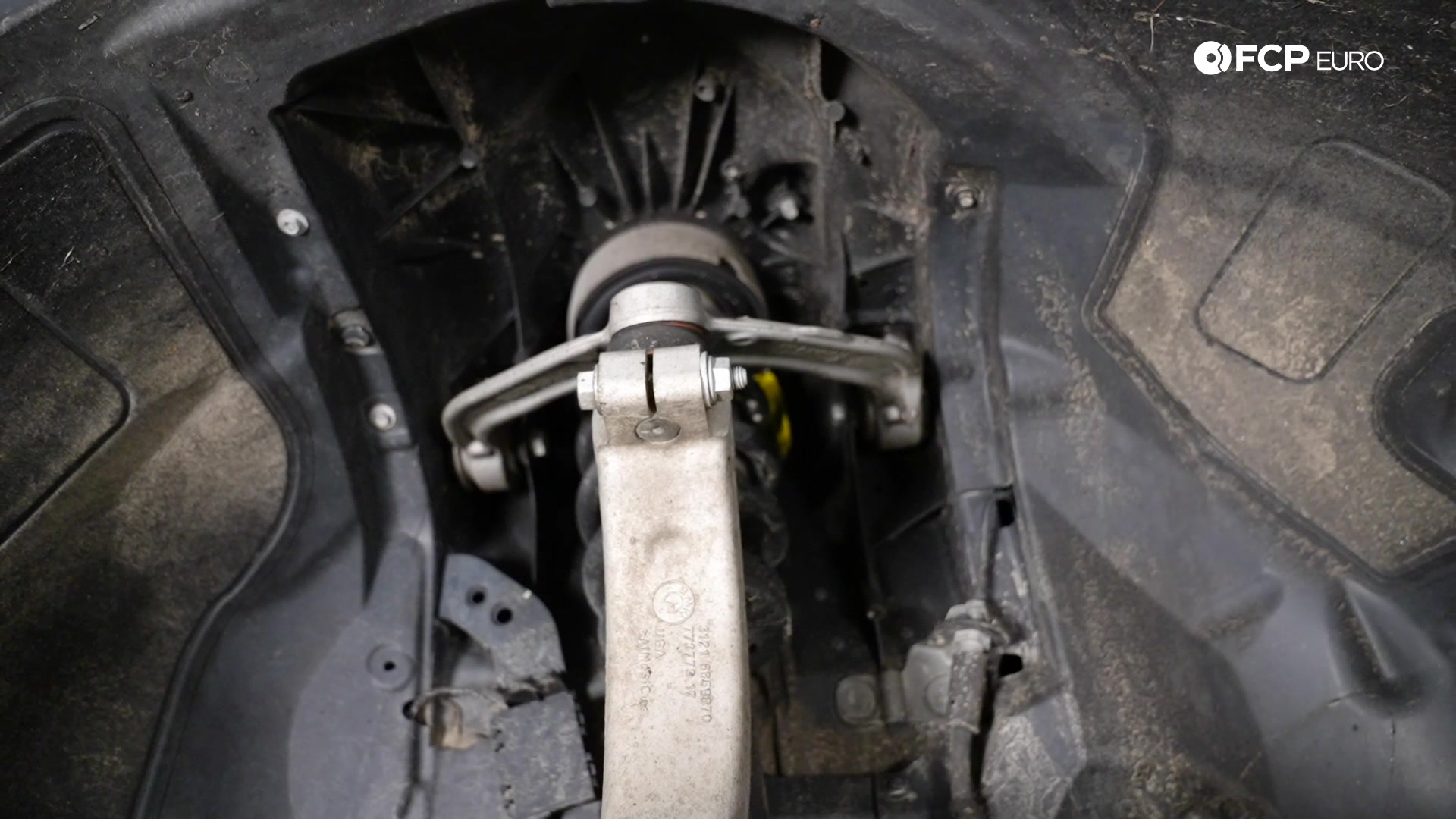
The largest problem lies within the upper wishbone design. BMW put the car together without any camber adjustability for the upper wishbone. That becomes an issue if the chassis or the arm gets tweaked to alter the suspension geometry. Once damaged, the technician performing an alignment will be unable to set the alignment to factory specifications correctly. To get around that issue, BMW offers wishbones in different sizes to correct for the damage. However, those arms are very expensive, relatively speaking, and difficult to acquire. To get around that, Meyle now offers an upper wishbone with an adjustable ball joint to allow camber correction.
Standard Sway Bars
The standard sway bars are the passive kind found in just about every vehicle around the world. What makes them unique to BMW is that their bushings are vulcanized to the sway bar itself. Typically, the sway bar bushings are fitted around the bar as separate pieces, allowing a technician to replace them when worn. However, the vulcanizing process essentially fuses the bushing with the sway bar, making them impossible to replace individually. If a sway bar bushing fails, you’re in for a complete sway bar replacement. If that’s the case, you should also replace the sway bar links with it.
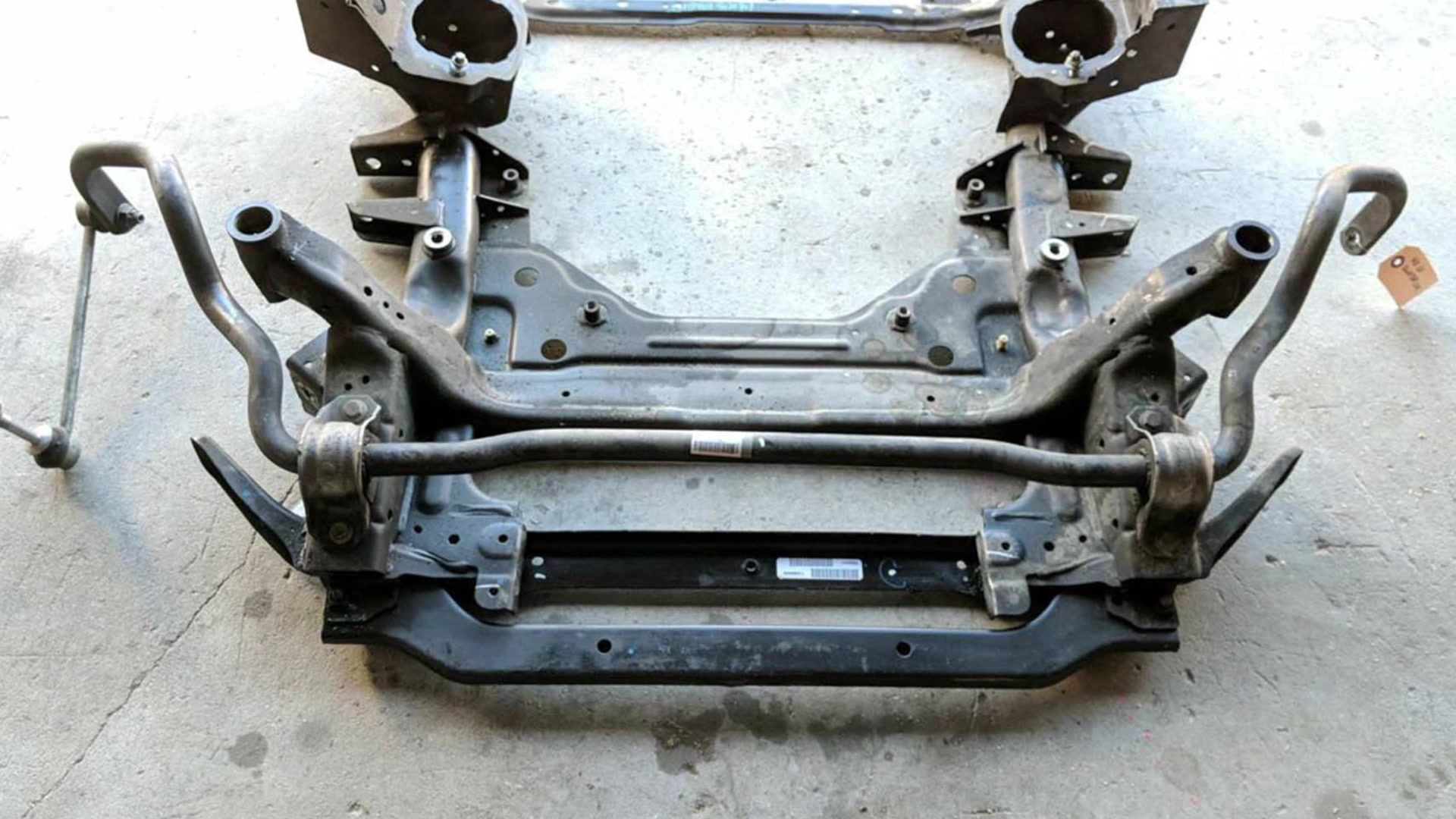
The sway bar links are very similar between the active and passive sway bars but do carry different part numbers per application. The links are fairly thin steel rods with two ball joints, one on each end to join the sway bar’s end with the strut. Sometimes, these will wear fairly quickly and begin to cause a tinny clicking sound as you drive over uneven surfaces. They can also present themselves as a faint knock or clunk over those same conditions.
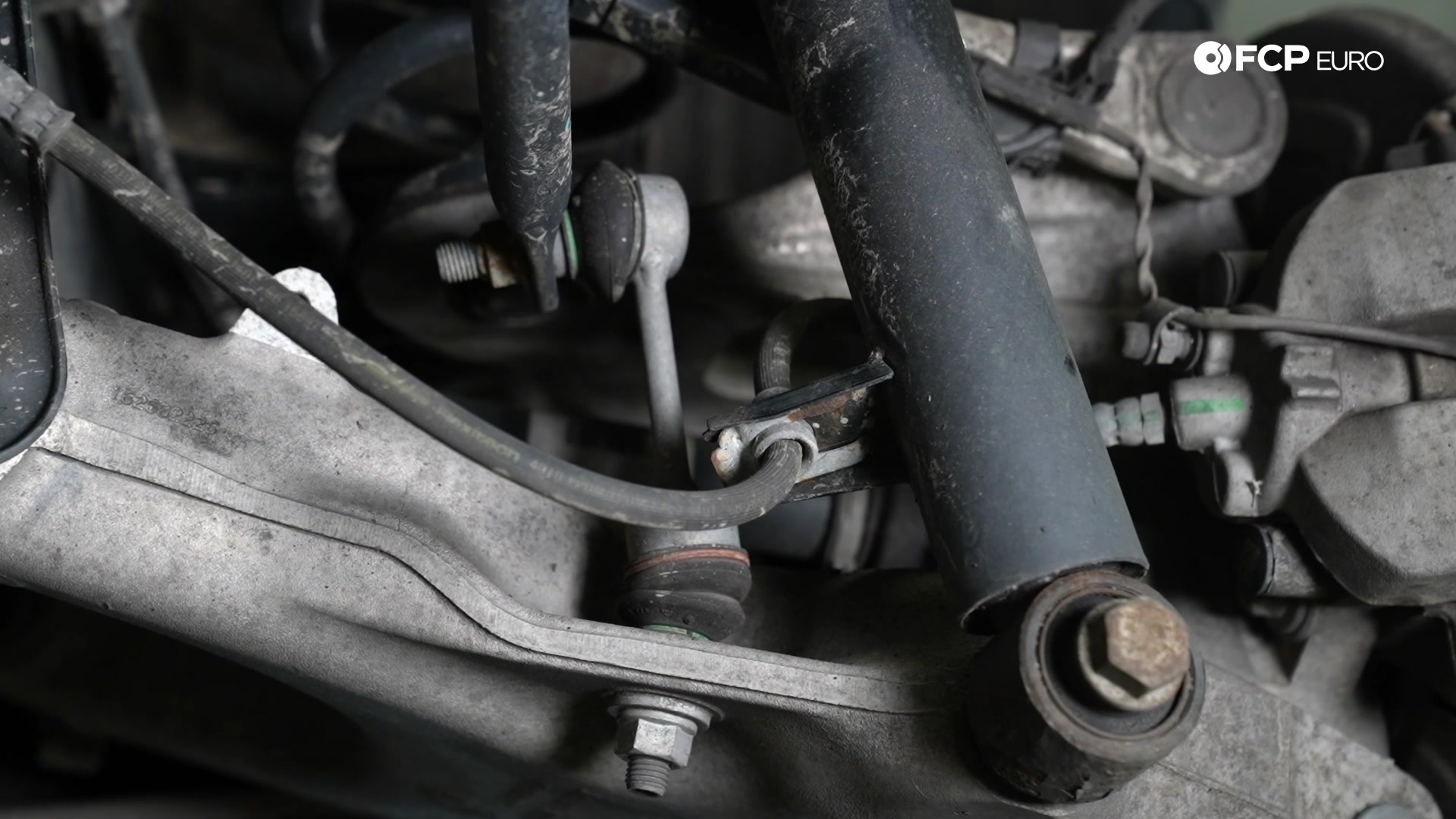
Dynamic Drive (Active Roll Stabilization)
BMW’s Dynamic Drive, or Active Roll Stabilization, uses hydraulically controlled sway bars with motors mounted at their centers to provide a variable stiffness depending on the situation. It is a complex system with many expensive moving parts that, unfortunately, can go wrong with age. Most commonly, you’ll see leaking fluid from the hydraulic lines, failed valve blocks, and failed pumps.
The hydraulic system that controls the bars uses the power steering pump and its fluid. The excess pressures put on the system can cause pump failure and line failure. Additionally, the valve block that actuates and distributes the fluid can fail. Warning signs from these failures may appear as pressures too low or too high, or in the form of odd clicking noises after coming to a stop or going around corners. Any of these issues will result in warning messages appearing on the dashboard. Less commonly are failures of the ARS motor on the sway bars themselves. The symptoms are the same, leaking fluid and odd clicking noises, so taking your BMW to a dealership or independent shop for diagnosis is a smart way to go.
Rear Lower Control Arms
The rear lower control arm, or swing arm, is the largest single rear suspension piece, not including the subframe. The large cast aluminum piece is generally reliable as there really isn’t much to go wrong. Bends in the arm require significant force, which will likely damage other suspension components.

What you need to look out for are worn bushings and ball joints. The arm’s inner bushings are responsible for carrying a lot of the suspension’s load and do wear because of that. According to BMW, the bushings aren’t serviceable, meaning you’ll need to replace the entire arm, at around $600, to replace the bushings. Thankfully Lemforder, the company that makes the arms for BMW, offers individual replacement bushings.
Rear Upper Control Arms
Like the front control arms, the bushings and ball joints they use are the big wear items. As with the rest of the bushings and ball joints, they’ll cause a vague and shifty feeling from the rear end when worn. The standard replacement procedure is to replace the entire arm as the ball joints aren’t replaceable. These upper arms are responsible for setting the camber and toe in the rear, so their condition is extremely important to the alignment of the rear suspension.
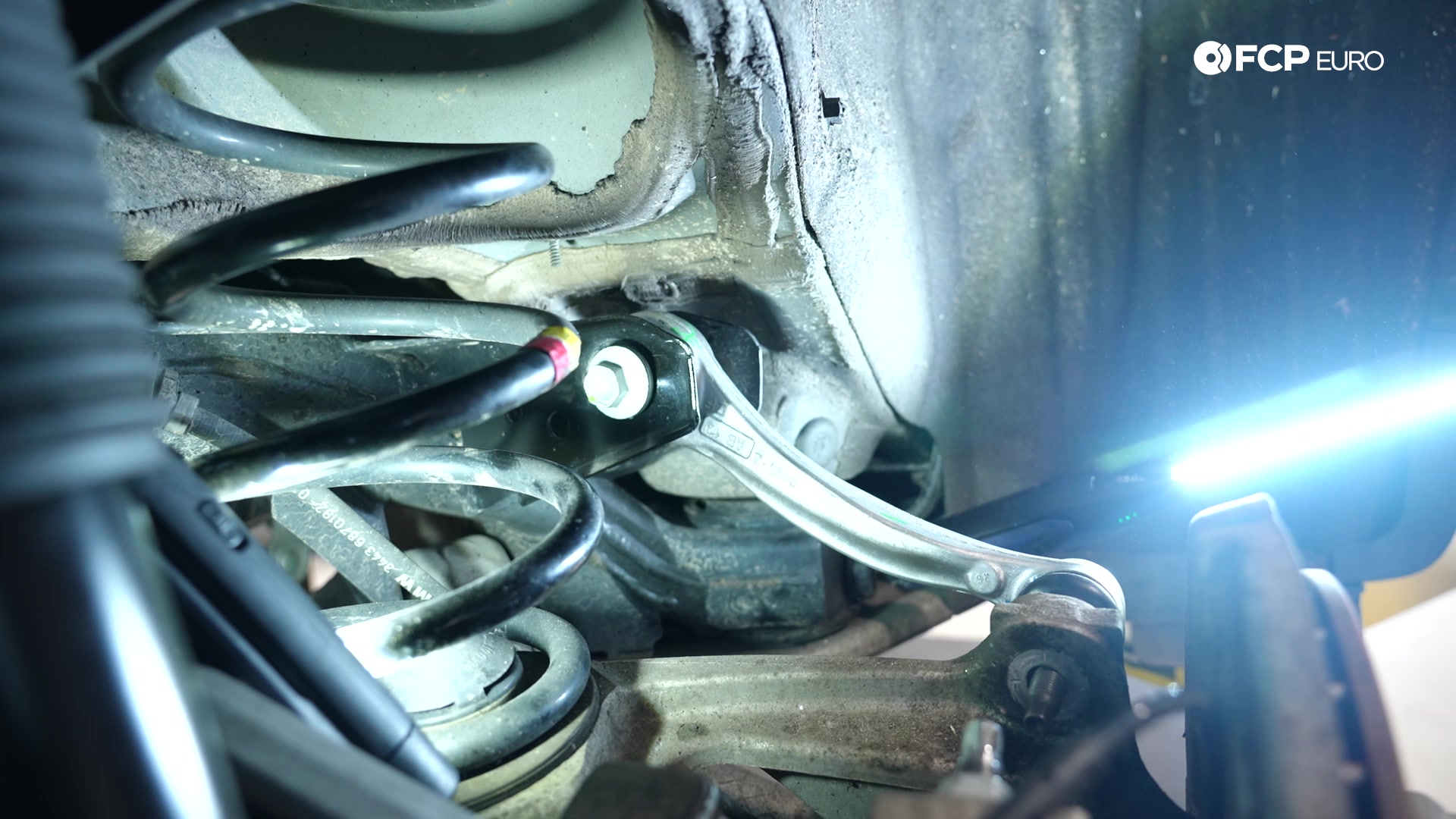
Air Suspension
The rear air springs are a fairly common point of failure on any X5 and X6. Most commonly, the springs will develop small leaks causing them to deflate while the vehicle is off. Even if the compressor is able to keep them filled during operation, a deflated bag is the beginning of a larger issue. Continually deflating bags will place an extra strain on the compressor. Dealing with faulty bags for too long will cause the compressor to burn out, leaving you with a significantly larger repair bill.
Air spring replacement is actually a pretty DIY-friendly job. Special tools aren’t required, and aftermarket replacement bags are available for tighter budgets. It’s best to replace the springs as a pair rather than individually, too, as bags typically fail together.
BMW F15/F16 X5/X6 Coil Suspension Maintenance
There isn’t much anyone can do in terms of coil spring maintenance. The springs are wound from steel and painted black. As the springs are subject to driving, dirt, rocks, sand, and general road debris will wear through the paint and expose the steel underneath. The springs will crack and can break completely if exposed to enough corrosive material and are subject to constant abuse. The best thing you can do for them is to keep them as clean as possible. Use a hose to wash off any loose debris and grit from the springs during a car wash. That’ll reduce the amount of abrasive material on the springs, helping the protective paint last a bit longer.
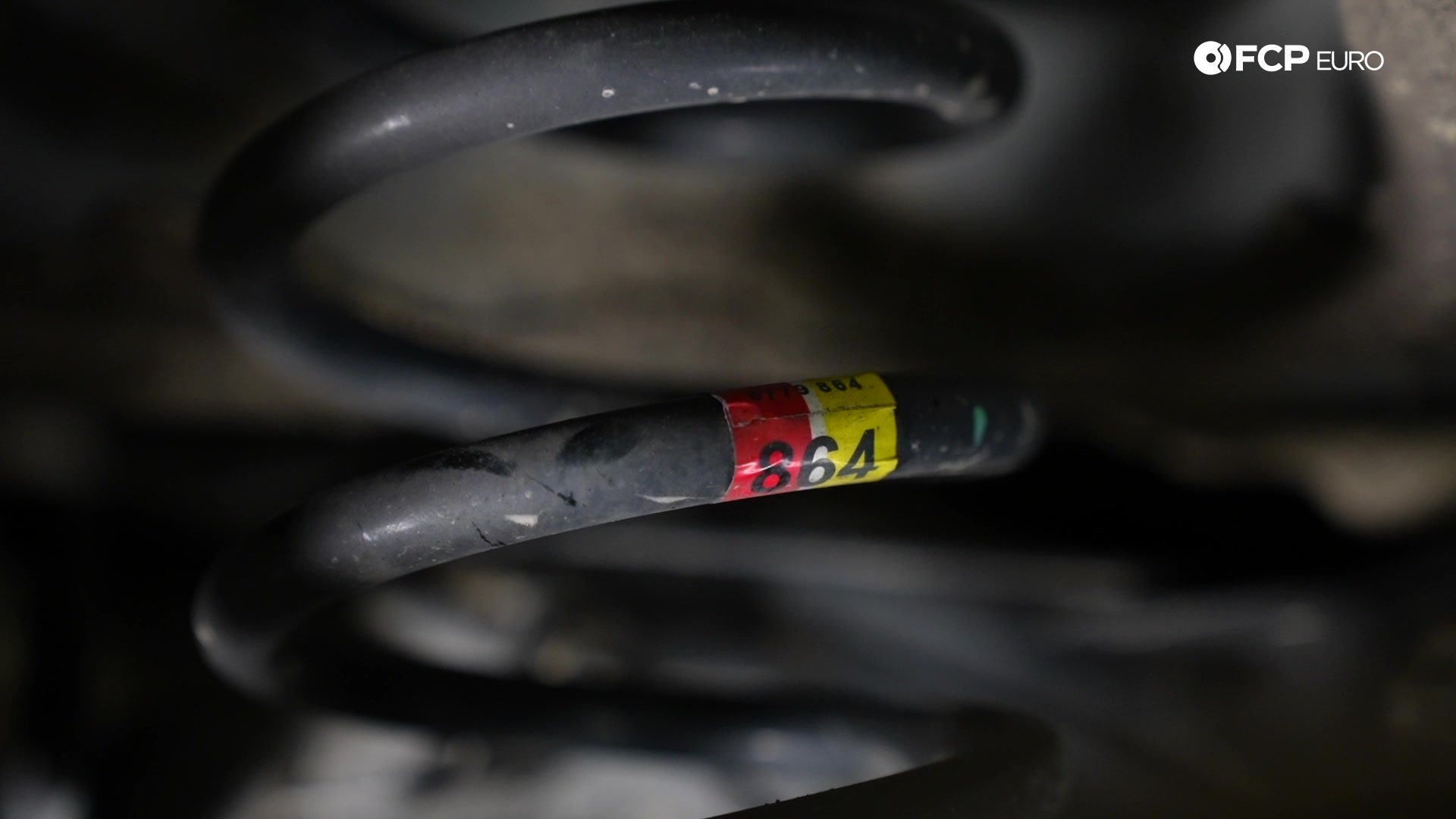
You’ll notice some very intense sagging from whichever corner of the vehicle has a snapped spring if it has one. Replacement springs are available, but BMW requires the vehicle’s VIN to acquire the correct part. The springs aren’t earth-shatteringly expensive and the repair process can be done in a driveway setting with the correct hand tools.
BMW X5 & X6 Suspension Upgrades (F15 & F16)
The X5 and X6 aren’t really part of the aftermarket suspension tuning scene. However, a few parts are available that can change the ride and handling dynamics of the big SUVs.
Springs
The easiest and most common upgrade to these suspension systems is the installation of sport lowering springs. The X5/X6 are no strangers to the fitment scene and the aftermarket has accommodated them in the form of lowering springs. Both Eibach and H&R offer lowering springs designed to take off around an inch from the stock ride height. They also feature stiffer compression rates to give the SUVs a sportier-feeling ride. For around four times the cost of the Eibachs or H&Rs, AC Schnitzer offers a spring set. The springs are made by Eibach to AC’s specifications and feature a very similar drop to the other springs.
Struts/Shocks
Throwing on a pair of lowering springs and calling it a day is certainly the easy thing to do, but it sure isn’t the right thing to do. The springs work with the dampers to control the chassis’s vertical movement as it rides on the suspension. The stock dampers are paired with the stock springs and are optimized for a certain amount of suspension travel. Using lowering springs significantly shortens that travel and places the bottom of the average stroke perilously close to the bottom of the shock’s travel. Over enough use, the aftermarket springs will wear out the OE damper much quicker than the OE springs.
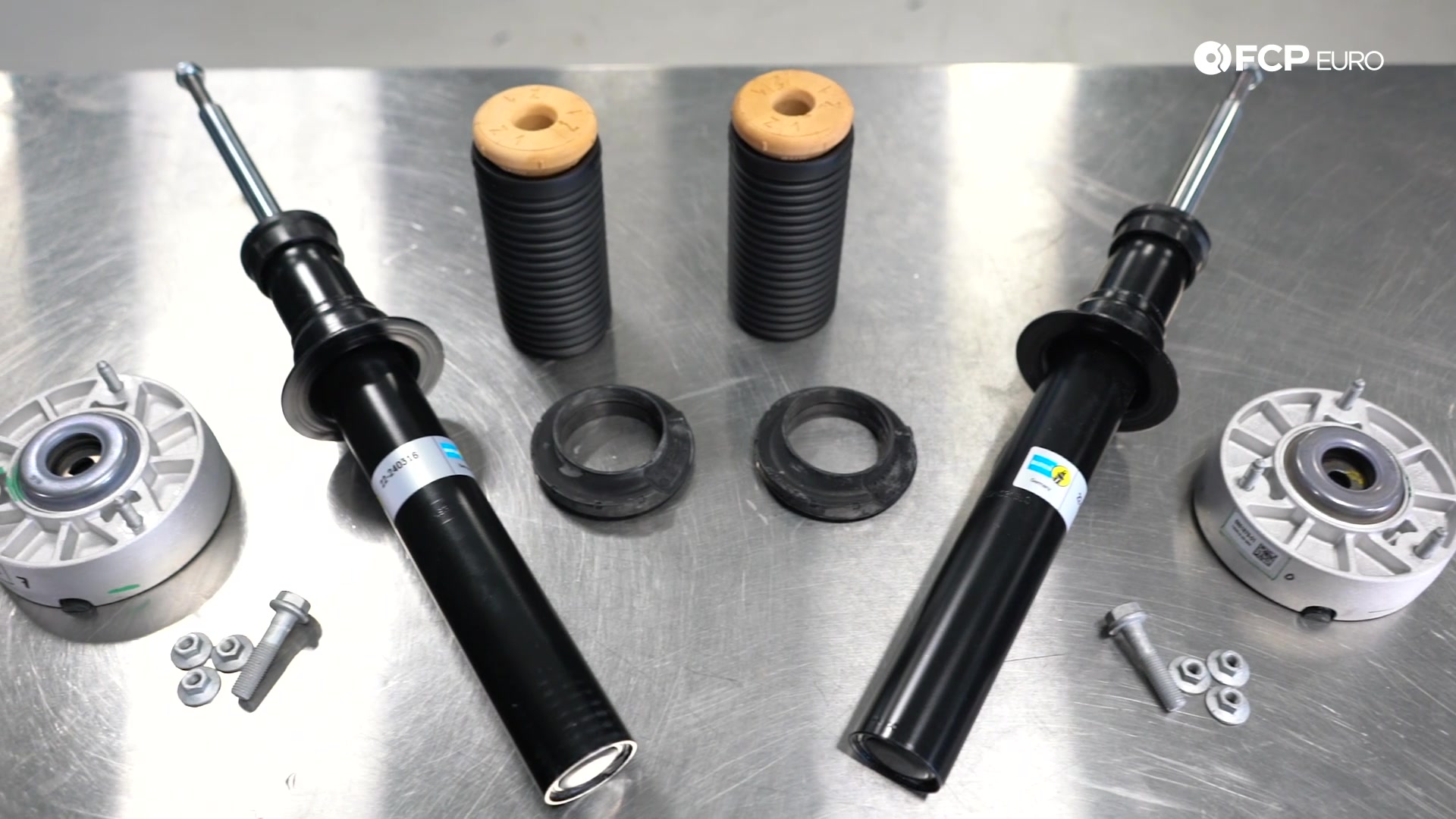
To work around that, you need to upgrade your dampers. Bilstein is the OE provider of the X5/X6 shocks and struts, and they offer upgraded B6 performance dampers that will work better with the aftermarket lowering springs. The B6 shocks and struts have had their compression and rebound profiles adjusted and designed for a reduced stroke and stiffer spring. They make a much better pairing with the lowering springs, offering better ride quality, more control, and a longer lifespan than the OE shocks.
Coilovers
If you’re dead set on fitting the best suspension possible to your BMW SUV, then look no further than the KW Variant 3. For right around $3000, you can have a complete front and rear coil-over kit that will work with the factory air springs. The included dampers have individual compression and rebound adjustments and will not work with the OE Dynamic Damper Control system. KW includes a DDC cancellation kit with the coilovers to eliminate any potential error messages from the disconnected suspension electronics.
BMW X5 & X6 Brake Overview & Specifications (F15 & F16)
The brakes fitted to the F15/F16 generation of X5/X6 are a bit simpler than the suspension. Each non-M X5 received a unique brake package, while the M Performance Brakes were also an option. Here are the specifications of each system.
xDrive35i Brake Specifications
The brakes fitted to the 35i and 35d models are the smallest in the X5/X6 range. Both the front and rear use a sliding caliper with a single-piston. Front and rear rotors are vented but feature solid faces without any slotting or drilling. The brake pads are a ceramic compound.
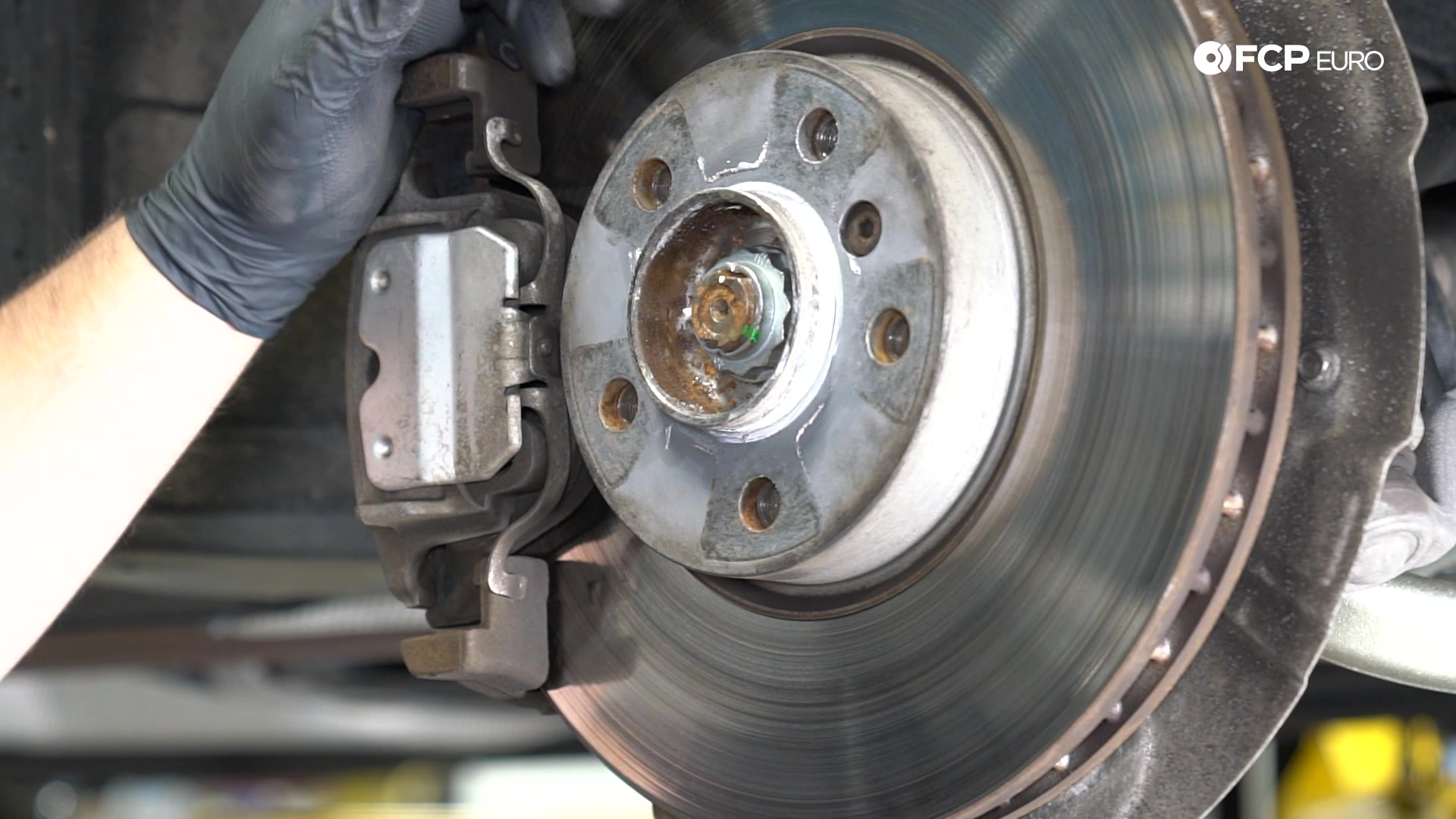
Brake Calipers (Front)
- Caliper Type: Sliding
- Color: Raw Steel
- Piston count: 1
Brake Calipers (Rear)
- Caliper Type: Sliding
- Color: Raw Steel
- Piston count: 1
- Size and Type: 332mm
- Material: Steel
- New Thickness: 30.0mm
- Replacement Thickness: 28.4mm
- Size and Type: 320mm
- Material: Steel
- New Thickness: 20.0mm
- Replacement Thickness: 18.4mm
xDrive40e Brake Specifications
The brakes fitted to the 40e model used a slightly larger front rotor than the 35i. Both the front and rear use a sliding caliper with a single-piston. Front and rear rotors are vented but feature solid faces without any slotting or drilling. The brake pads are a ceramic compound.
Brake Calipers (Front)
- Caliper Type: Sliding
- Color: Raw Steel
- Piston count: 1
Brake Calipers (Rear)
- Caliper Type: Sliding
- Color: Raw Steel
- Piston count: 1
- Size and Type: 348mm
- Material: Steel
- New Thickness: 30.0mm
- Replacement Thickness: 28.4mm
- Size and Type: 320mm
- Material: Steel
- New Thickness: 20.0mm
- Replacement Thickness: 18.4mm
xDrive50i Brake Specifications
The 50i model received the largest non-M calipers and rotors fitted to the F15 generation. They feature rotors with a larger diameter and wider thickness for a better heat dispersion required by the more powerful and heavier engine. A dual-piston front sliding caliper is matched with a single-piston slider at the rear. Front and rear rotors are vented but feature solid faces without any slotting or drilling. The brake pads are a ceramic compound.
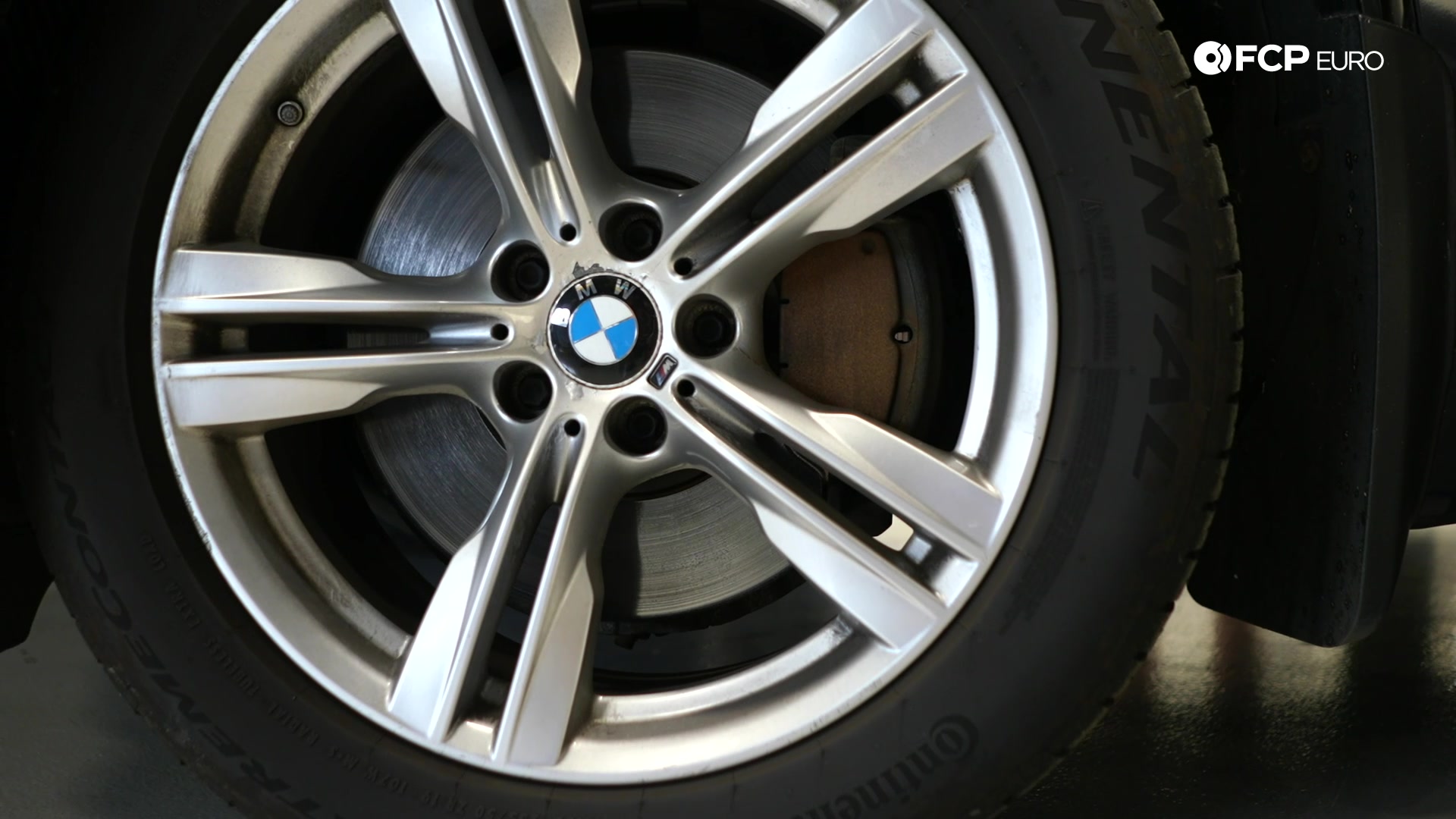
Brake Calipers (Front)
- Caliper Type: Sliding
- Color: Raw Steel
- Piston count: 2
Brake Calipers (Rear)
- Caliper Type: Sliding
- Color: Raw Steel
- Piston count: 1
- Size and Type: 365mm
- Material: Steel
- New Thickness: 36.0mm
- Replacement Thickness: 34.4mm
- Size and Type: 345mm
- Material: Steel
- New Thickness: 24.0mm
- Replacement Thickness: 22.4mm
M Performance Brakes
Optionally, the X5 or X6 could’ve been fitted with the M Performance brakes. They utilize massive four-piston fixed front calipers and a large single-piston slider in the rear. The front and rear rotors are also significantly larger than the 50i model. Front and rear rotors are directional and vented but feature solid faces without any slotting or drilling. However, the X5M's drilled rotors will work instead of the blank-faced units. The brake pads are a semi-metallic compound for improved braking response and performance. All M Performance Brake kits, or MPBKs, are painted blue.
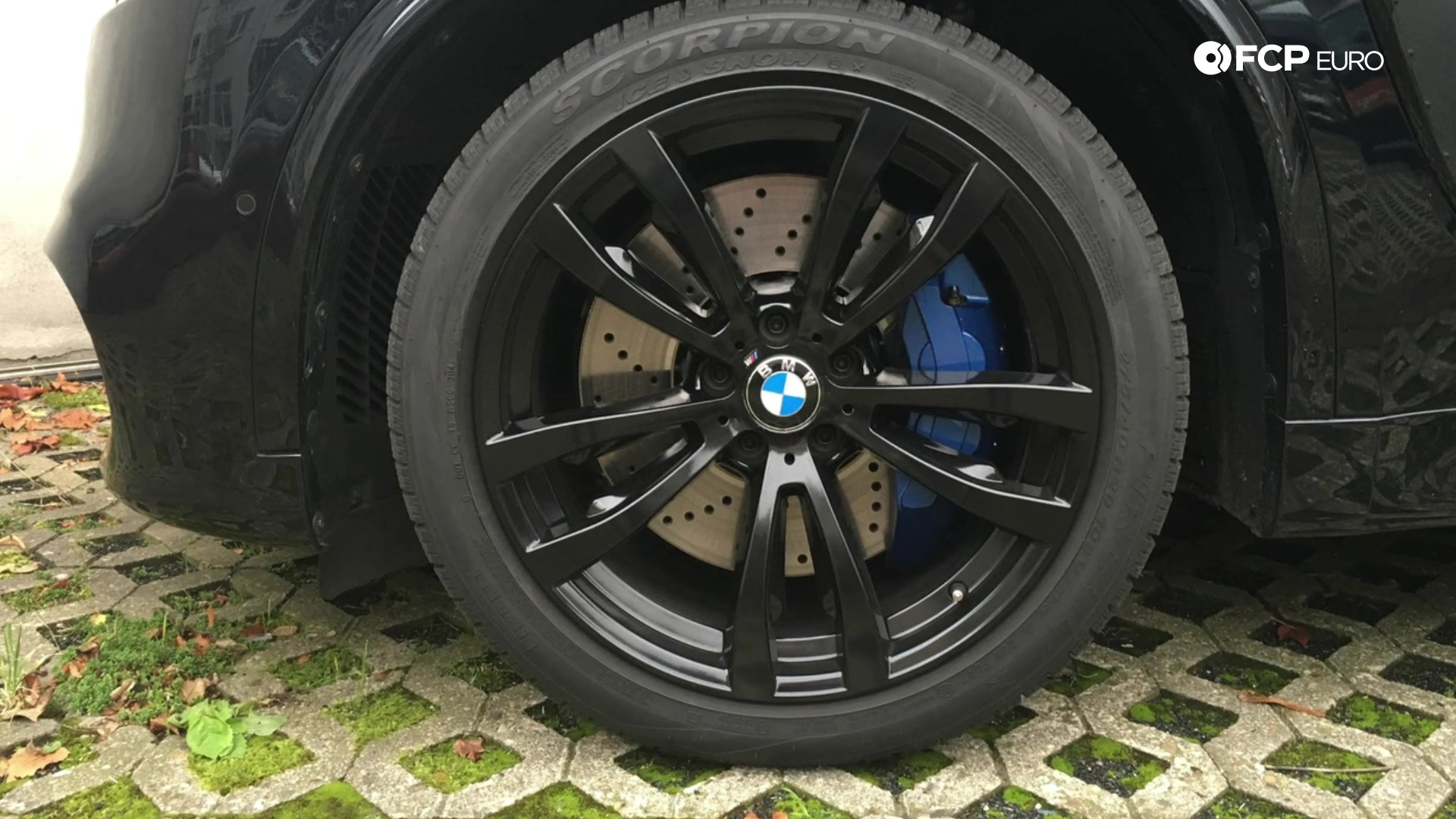
Brake Calipers (Front)
- Caliper Type: Fixed
- Color: Blue
- Piston count: 4
Brake Calipers (Rear)
- Caliper Type: Sliding
- Color: Blue
- Piston count: 1
- Size and Type: 395mm
- Material: Steel
- New Thickness: 36.0mm
- Replacement Thickness: 34.4mm
- Size and Type: 385mm
- Material: Steel
- New Thickness: 24.0mm
- Replacement Thickness: 22.4mm
BMW X5 & X6 Brake Service & Repair (F15 & F16)
BMW uses the same sliding style caliper across nearly all of its models. The caliper itself is similar to the overwhelming majority of brake calipers fitted by every manufacturer today. They are effective, inexpensive, and easy to work on, making them the ideal choice for any mass-produced car. The necessity for brake service can be determined by a few different factors, although the brake pad wear sensor will usually bring it about.
A wear sensor is fitted to one of the front brake pads and one of the rears. As the pads wear down, the sensor contacts the disc and trips the service message that appears in the instrument cluster. You don’t need to stop what you’re doing and service your brakes immediately, but you’ll have around 1,000 miles worth of brake pad left to use.
Judging when it’s time to replace the discs is a little trickier than the pads. BMW specifies that their rotors should be replaced after just 1.6mm of material has worn off of the rotor. While that doesn’t sound like much, they should last through at least two sets of OE-type pads before reaching replacement. Examine the rotors' surface to get a general idea of their remaining lifespan. The pads don’t contact the disc’s outer edge, so a large lip will indicate a need for replacement.
In extreme cases, the brake rotor can warp. It happens when the rotor is exposed to too much heat causing the disc to lose its shape ever so slightly. It can also occur when too much pad material becomes embedded in them. You’ll know when they become warped when the brakes make the whole car shudder at certain speeds. In most cases, a warped rotor isn’t the end of the world; instead, it’s just an annoying reminder to change the discs. There are two ways to solve a warped rotor; replacing it or having it resurfaced. Depending on the severity of the warping, a machine shop can take off the top layer of material to re-flatten the surface. However, it’s easiest just to replace them altogether.
The brake fluid also eventually needs replacing. Brake fluid absorbs water because of its chemical composition. Water in brake fluid significantly reduces the boiling point, weakening the fluid. As it gets weakened, the brake pedal will become soft and spongy, giving you a poor response through the pedal.
Replacing the brakes on your F15 X5 is a very straightforward job and one that you can accomplish at your home. Follow along with the video below as our BMW catalog manager, Gareth, takes you through the service on his F15 X5 xDrive35i.
BMW X5 & X6 Brake Upgrades (F15 & F16)
The best upgrade you could do to increase the stopping power of your X5 is to install the factory M Performance Brake Kit. They utilize a more aggressive brake pad compound designed to give more bite, along with the physically larger size. The trade-off is that they will cause a significant increase in the amount of brake dust present. To save a bit of money, 35i and 35d owners can fit the slightly larger calipers and rotors from the 50i models. They will bolt right onto the 35i knuckles and will plug right in with the correct rotor and pads.
Without increasing size, going to a more aggressive brake pad compound is going to give a better feel and increased stopping power. Choosing the right pad for your application can be tricky but we can help with that. The pad compound directly relates to how well the brakes grip the discs. The standard ceramics produce little noise and minimal dust for maximum luxury convenience. More aggressive semi-metallic pads will bite harder and withstand the increased temperatures but will wear at a faster rate. Additionally, drilled or slotted rotors can improve braking performance. The drilled or slotted surfaces are designed to help dissipate the heat produced by the brakes. Keeping the brakes from overheating ensures that they’ll continue to perform without fail.
Non-OEM upgrades are limited to Brembo’s GT kit or one from Stoptech. For around $4000-5000, you can have a six-piston fixed front caliper with two-piece rotors. The Brembo rotors are 405mm in diameter, and 34mm thick and use a steel rotor ring bolted to an aluminum hat. The Stoptechs are also a two piece rotor but feature a smaller 380mmx32mm size. The two-piece design sheds an enormous amount of weight from the rotors while providing increased heat dissipation. For another $3800, you can add Brembo's rear brake kit. That swaps the single-piston sliders for four-piston fixed units. The rotors are smaller than the MPBK and are a one-piece design. The MPBK is going to be cheaper to put together and will be supported by a BMW warranty if the dealership installs them.
So there you have it, everything you need to know about the suspension and brakes on the F15 X5 and F16 X6. BMW’s various dynamic and active suspension components can cost you but also deliver a driver-focused and agile ride. The so-called SAVs are now readily available on the used market in various states of condition, and knowing their pitfalls should guide you in the right direction. So what combination of suspension and brakes do you think is best? As always, if there’s anything we missed or you think should change, let us know in the comments below. Follow along with the blog and subscribe to our YouTube channel for more great content!











